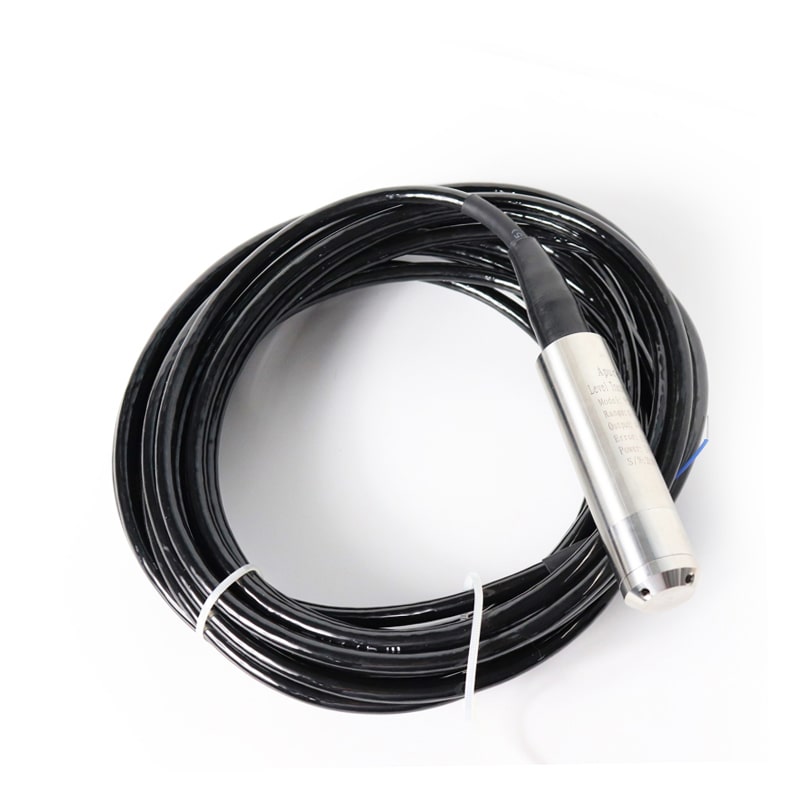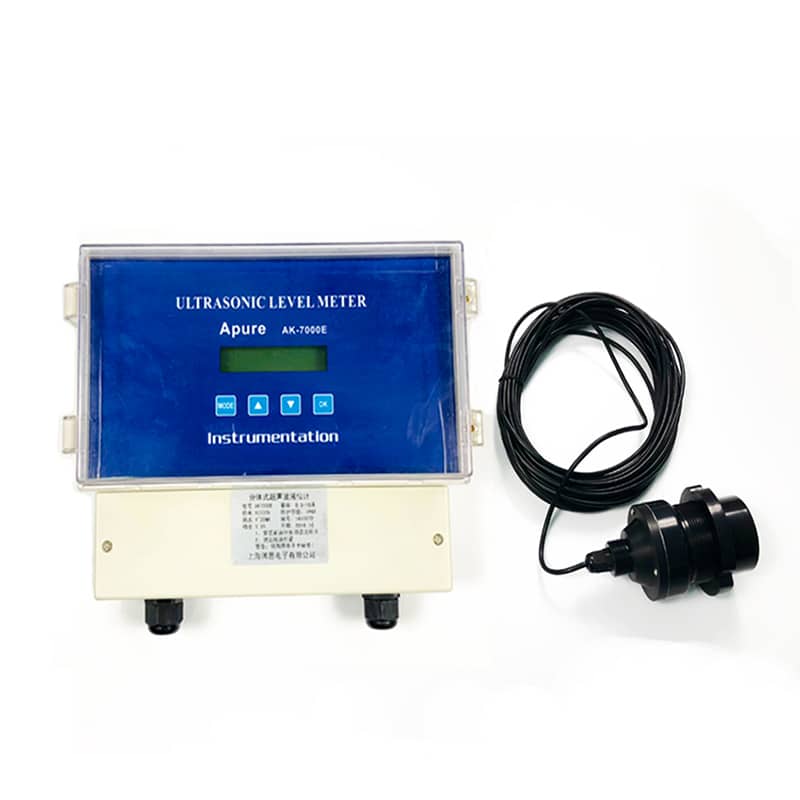Deep well water level sensors are specialized devices designed to measure and monitor water levels in deep wells or boreholes. These sensors are engineered to withstand the harsh conditions encountered in deep well applications and provide accurate and reliable water level measurements.
Principle of deep well water level sensor
The principle of operation of deep well water level sensors is based on pressure measurement. The pressure of the water is directly proportional to the height of the water level, so by measuring the pressure of the water, the water level can be measured indirectly.
There are two main types of deep well water level sensors: capacitive and ultrasonic.
The principle of operation of capacitive water level sensors is based on changes in capacitance. The capacitor consists of two parallel conductive plates with air or liquid filling between them. When the water level rises, water fills the capacitor, causing the capacitance value to increase. The change in capacitance value can be measured by a circuit and converted to a water level reading.
Ultrasonic water level sensors work based on the propagation time of ultrasonic waves. Ultrasound is a type of sound wave that has a frequency above the range of human hearing. Ultrasonic sensors emit ultrasonic signals and receive ultrasonic signals that are reflected back by the water surface. Based on the propagation time of the ultrasonic waves, the water level height can be calculated.


Pressure measurement
Both capacitive water level sensors and ultrasonic water level sensors need to measure the pressure of the water. Capacitive water level sensors immerse a capacitor in the water, so they can measure the water pressure directly. Ultrasonic water level sensors use a pressure transducer to measure water pressure.
A pressure sensor is a device that converts pressure into an electrical signal. There are various types of pressure sensors including resistive, capacitive, inductive and optical.
Apure has instruments that specialize in measuring pressure data, such as the YJ Water Bourdon Tube Pressure Gauge and the YBC Differential Digital Pressure Gauge.
Water level conversion
Capacitive water level sensors convert capacitance values to water level readings by using a standard curve. The standard curve is experimentally measured and correlates the capacitance value to the water level height.
Ultrasonic water level sensors convert ultrasonic propagation time to water level readings by using a formula. The formula correlates the ultrasonic propagation time with the water level height.
Formula:
Water Level = (Total Distance – Sensor to Tank Bottom Distance) / 2
Accuracy
The accuracy of a deep well water level sensor depends on the accuracy of the pressure measurement and the accuracy of the water level conversion. The accuracy of the pressure measurement depends on the type and quality of the pressure sensor. The accuracy of the water level conversion depends on the accuracy of the standard curve or formula.
In practice, the accuracy of deep well water level sensors is usually ±1% to ±5%.
Other factors
The measuring range of the deep well water level sensor also needs to be considered. Deep well water level sensors usually have a measuring range of 0 to 100 meters or 0 to 200 meters.
Deep well water level sensors also need to be considered for reliability. Deep well water level sensors are usually installed underground and therefore need to have good reliability.
Main features of deep well water level sensor
Many deep well water level sensors utilize a pressure sensor to measure the hydrostatic pressure generated by the water column above the sensor. This pressure is then converted to a water level reading.
- Water-resistant design
These sensors are typically water-resistant and can be operated under water to accurately measure water levels at various depths within the well.
- Corrosion resistance
Corrosion factors in deep well environments are primarily impurities in the water (e.g., salt, sulfides, chlorides, etc.), gases in the groundwater (e.g., carbon dioxide, hydrogen sulfide, etc.), and the temperature of the groundwater, with higher temperatures resulting in faster corrosion rates.
Since they are deployed in potentially corrosive environments, these sensors can be made of stainless steel, plastics, ceramics, etc.
- Accuracy and stability
Designed to provide precise and stable measurements in harsh conditions, they deliver consistently accurate water level data.
- Multiple output options
Deep well water level sensors typically offer multiple output options such as analog, digital, or wireless that can be integrated with different monitoring systems.
- Installation flexibility
Deep well water level sensors are usually installed underground and therefore need to be able to withstand the effects of water, sediment, dirt, dust and other external elements. Enclosed housings and sealing technology are important measures to protect deep well water level sensors from these effects. Enclosed housings prevent water and other external elements from coming into direct contact with the sensitive parts of the sensor. Enclosed housing is usually made of metal or plastic, and has good sealing.
Types of deep well water level sensors
Apart from these two main types, there are other types of deep well water level sensors such as:
- Pressure water level sensors: this type of sensor uses a pressure sensor to directly measure the pressure of the water.
- Float type water level sensors: this type of sensor uses a float to measure the water level. The float moves as the water level rises or falls, which drives a change in the sensor’s output signal.
- Photoelectric Water Level Sensors: These sensors use optical methods to measure water level. Light from a light source is reflected back by the water surface, and the sensor detects the intensity of the reflected light and converts it into a water level reading.
Application scenarios for deep well water level sensors
- Groundwater monitoring: Used in groundwater monitoring systems to measure water levels, assess aquifer health, and manage water resources.
- Irrigation and Agriculture: Ensure proper water levels in agricultural irrigation systems to optimize water use and crop health.
- Industrial and Municipal Wells: Monitor water levels in wells used for industrial processes or municipal water supplies to ensure adequate water supplies.
- Environmental Monitoring: Used for environmental research to track water levels in natural or man-made wells for ecological studies or conservation efforts.
Deep well water level sensors play a key role in a variety of industries and applications by providing accurate and continuous monitoring of deep well water levels, helping to effectively manage resources and protect the environment.
Installation and maintenance recommendations for deep well water level sensors
Installation
The following steps need to be followed to install the deep well water level sensor:
- Choose a suitable location. The deep well water level sensor should be installed in a location where the groundwater level is relatively stable to avoid the influence of external factors.
- Drill the hole. The diameter of the drilled hole should be larger than the outer diameter of the sensor so that the sensor can be freely lowered.
- Installation of the sensor. Lower the sensor into the borehole and seal the interface with sealing material.
- Test the sensor. Test the measurement accuracy of the sensor and make sure that the sensor is working properly.
Maintenance
The following steps need to be followed for maintenance of the deep well water level sensor:
- Periodically check the appearance of the sensor. Check the sensor for damage or corrosion.
- Clean the sensor regularly. Clean the outside of the sensor and remove dirt and debris from the inside of the sensor.
- Calibrate the sensor regularly. Calibrate the sensor to ensure measurement accuracy.
Summary
Deep well water level sensors are an indispensable tool in water resource management, capable of monitoring groundwater levels in real time and providing timely and accurate groundwater level information to water resource managers.
Apure offers a wide range of water level measurement devices, including magnetic level sensors and radar level sensors in addition to capacitive level sensors and ultrasonic level sensors. Please contact us if you have questions.
